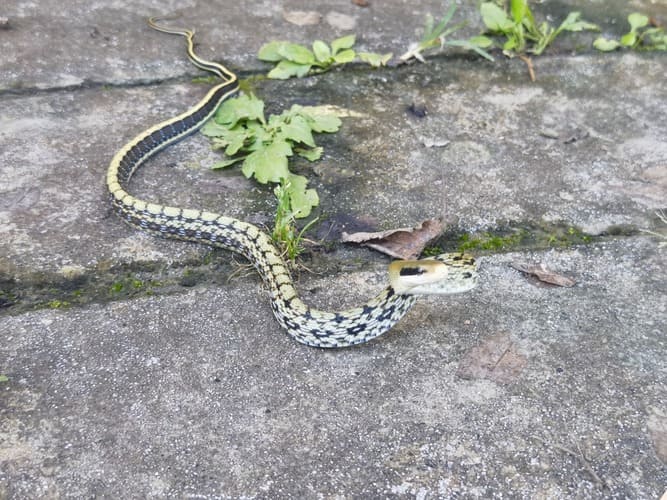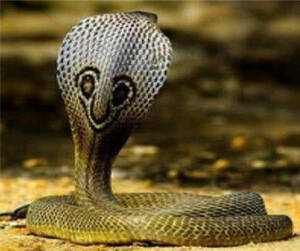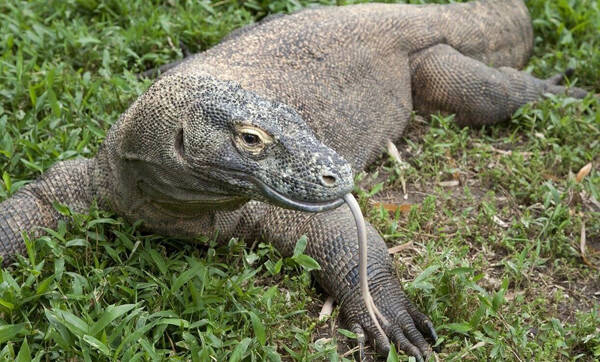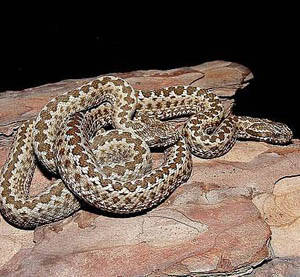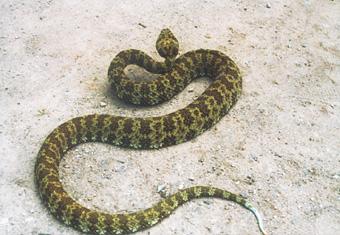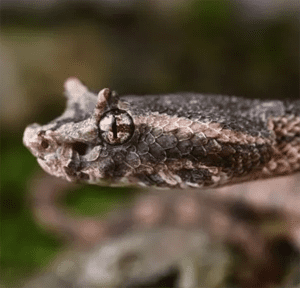Daboia russelii siamensis
IUCN
LCBasic Information
Scientific classification
- name:Daboia russelii siamensis
- Scientific Name:Daboia russelii siamensis,Leopard, leopard, coin spot, ancient coin window, round-spotted viper
- Outline:Squamata
- Family:F.Muscidae G.Muscidae
Vital signs
- length:About 100 cm
- Weight:1.5kg and above
- lifetime:About 16 years
Feature
Slow in movement, fierce in nature, and extremely poisonous
Distribution and Habitat
Distribution in China: Fujian (Zhao'an, Quanzhou, Hui'an, Xianyou, Nan'an), Taiwan (Hualien, Ruisui, Taitung, Kaohsiung, Hengchun, Chenggong, Pingtung, Taipei), Guangdong (Shaoguan, Guangzhou), Guangxi (Nanning).
Distribution outside China: Pakistan, India, Sri Lanka, Bangladesh, Myanmar, Thailand.
The round-spotted viper lives in plains, hills or mountains. Vertical distribution can reach up to 2,100 m above sea level. It mainly lives in open fields and grass. It is rarely found in dense wooded areas. It has been found curled up under agaves and cacti in Quanzhou, Fujian.
Appearance
Total length 648 (560+88) mm. The head is relatively large, slightly triangular, and clearly distinguished from the neck; the snout tip is blunt and round. The nostrils are large and located on the dorsal side of the head, that is, between the anterior nasal scales, upper nasal scales, and lower nasal scales; the anterior nasal scales are connected to the snout scales, and the upper nasal scales form a ridge above the nostrils, which forms a distinct snout scale with the ridge formed by the supraorbital scales above the eyes and the scales with ridges between these two ridges. There are two rows of small scales between the eyes, nostrils, and upper lip scales. There is a horizontal row of small scales between the supraorbital scales, 7 in total. Except for the two rows of small scales at the tip of the snout and a row of small scales on the inner side of the upper lip scales, the rest of the dorsal side of the head are clearly ridged. There are 11 upper lip scales, the fourth of which
Details
Daboia russelii siamensis is a venomous viper belonging to the genus Viper in the subfamily Viperidae of the suborder Viperidae. There are three subspecies, among which the Thai viper (Daboia russelii siamensis) is a second-level key protected animal in my country.
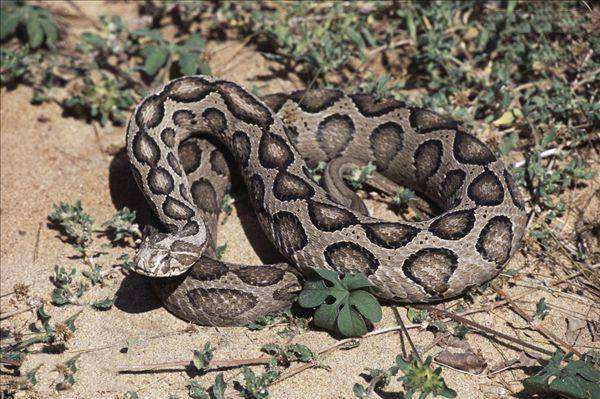
The round-spotted viper moves slowly. When attacking a target, the front of the trunk bends backward first. Then it suddenly leaves the ground and shoots forward to bite the target. And there is a phenomenon of biting and not letting go. The young snake is more fierce. When disturbed, the body keeps expanding and contracting. And it makes a "whooshing" sound, which can last for several minutes to half an hour.
When the weather is hot, the round-spotted viper hides in a cool and ventilated place. It can move to the rice fields during the autumn harvest. There are many cases of snake bites in September and October, especially in Guangzhou, Heshui, and Quanzhou, Fujian. The range of activities is in summer, and it is active day and night. It feeds on mice, birds, snakes, lizards and other frogs, and sometimes enters residential areas to feed on mice.
The round-spotted viper is ovoviviparous, with a mating period of November to April, a gestation period of 6 to 8 months, and a litter of 11 to 63 pups is born from August to October each year.
There are two types of toxins in the viper, one is hemorrhagic toxin and the other is neurotoxin. It is very rare to find snakes that have both toxins. In addition, the toxins of the viper can cause the poisoned person to have symptoms similar to a stroke, so the therapist may not be able to detect the poison in time, thus delaying treatment. The number of cases of death caused by viper bites is the highest among Asian snakes. The local Red Cross in Thailand has developed a serum specifically for viper toxins, called "Lu's viper serum".
The venom of the viper mainly contains blood circulation toxins, and the toxic components are mainly coagulant toxins, as well as hemolytic toxins, fibrinolytic toxins, anticoagulant components, platelet aggregation and denaturation components, and hemorrhagic toxins. The enzyme content is relatively high, mainly phospholipase A2, kallikrein, arginine esterase, hyaluronidase, etc. A PLA2 was isolated and purified from the venom of the Fujian round-spotted viper, with a molecular weight of 13.8kD, an isoelectric point of pH 10.4, a specific activity of 35μmol/min per mg, an optimal pH of 8.0, and an optimal temperature of 65°C. With lecithin as a substrate, the enzyme has obvious anticoagulant and hemolytic effects, and the LD50 of intravenous injection in mice is (0.5±0.12) mg/kg. In 1985, a PLA2 was also isolated from the venom of the round-spotted viper, a platelet inhibitory factor, which can inhibit the aggregation of human platelets caused by ADP, adrenaline, collagen or thrombin. This PLA2 has a strong inhibitory effect on the contraction of platelet clots, and the strength of the inhibitory effect is related to the dose. Heating the snake can reduce the activity of this PLA2 and its aggregation activity.
After being injured, the wound is swollen and painful, bleeding, acute onset, severe symptoms, fierce, subcutaneous bleeding forms ecchymosis. It often causes DIC, because the viper venom mainly acts on blood factor X. The initial stage is a large amount of rapid coagulation of the blood, and a large amount of coagulation factor is consumed in the blood. After that, the blood loses coagulation and the whole body bleeds severely. Some patients may suffer from anemia and jaundice, renal failure, and even pulmonary hemorrhage and cerebral hemorrhage due to hemolysis, and the mortality rate is high.
Listed in the "National List of Terrestrial Wildlife with Important Economic and Scientific Research Value under State Protection" issued by the State Forestry Administration of China on August 1, 2000.
Listed in the 2013 Red List of Endangered Species of the World Conservation Union (IUCN) ver3.1—Near Threatened (NT).
Listed in the China Biodiversity Red List—Vertebrate Volume, with an assessment level of Vulnerable (VU).
Listed in Appendix I, II and III of the Convention on International Trade in Endangered Species of Wild Fauna and Flora (CITES) 2019 Edition Appendix III
Protect wild animals and eliminate game.
Maintaining ecological balance is everyone's responsibility!

